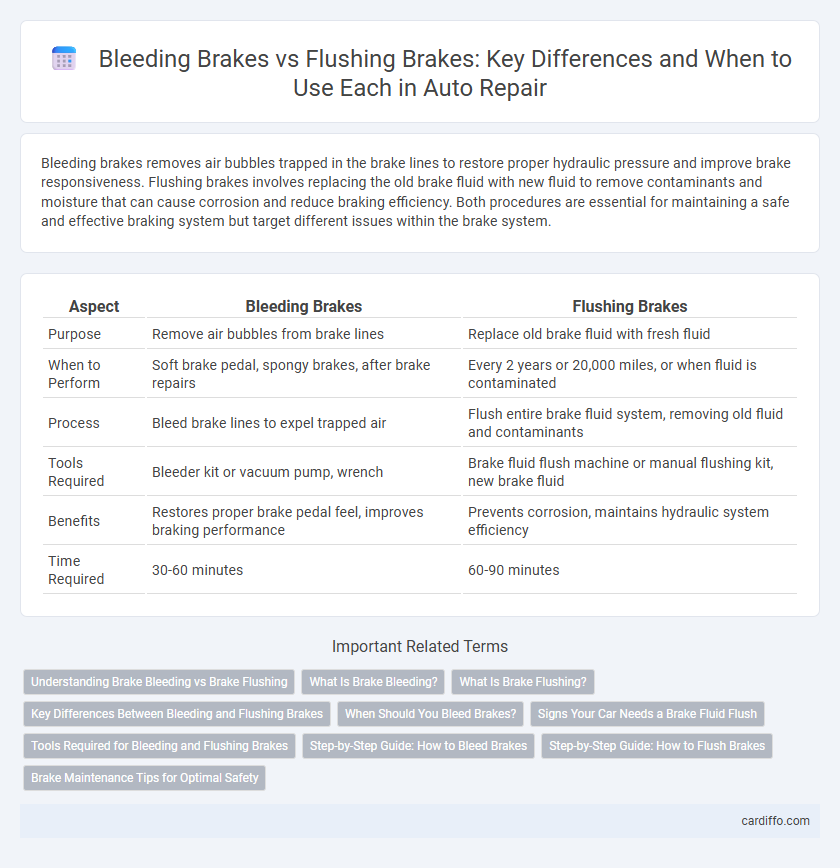Bleeding brakes removes air bubbles trapped in the brake lines to restore proper hydraulic pressure and improve brake responsiveness. Flushing brakes involves replacing the old brake fluid with new fluid to remove contaminants and moisture that can cause corrosion and reduce braking efficiency. Both procedures are essential for maintaining a safe and effective braking system but target different issues within the brake system.
Table of Comparison
| Aspect | Bleeding Brakes | Flushing Brakes |
|---|---|---|
| Purpose | Remove air bubbles from brake lines | Replace old brake fluid with fresh fluid |
| When to Perform | Soft brake pedal, spongy brakes, after brake repairs | Every 2 years or 20,000 miles, or when fluid is contaminated |
| Process | Bleed brake lines to expel trapped air | Flush entire brake fluid system, removing old fluid and contaminants |
| Tools Required | Bleeder kit or vacuum pump, wrench | Brake fluid flush machine or manual flushing kit, new brake fluid |
| Benefits | Restores proper brake pedal feel, improves braking performance | Prevents corrosion, maintains hydraulic system efficiency |
| Time Required | 30-60 minutes | 60-90 minutes |
Understanding Brake Bleeding vs Brake Flushing
Brake bleeding removes trapped air from the brake lines to restore hydraulic pressure and improve braking performance, while brake flushing replaces old brake fluid with new fluid to maintain system cleanliness and prevent moisture buildup that can cause corrosion. Understanding the difference helps in determining the right maintenance procedure based on symptoms such as spongy brake pedal feel or fluid discoloration. Properly bleeding brakes ensures safe braking response, whereas flushing protects the brake system from long-term damage and maintains optimal fluid quality.
What Is Brake Bleeding?
Brake bleeding is the process of removing air bubbles from the brake lines to ensure optimal hydraulic pressure and responsive braking performance. It involves opening bleeder valves on the brake calipers or wheel cylinders while applying the brake pedal to expel trapped air and old brake fluid. Proper brake bleeding prevents soft or spongy brake pedals and maintains effective stopping power for safety and reliability.
What Is Brake Flushing?
Brake flushing is a comprehensive maintenance procedure that removes contaminated brake fluid from the entire hydraulic system and replaces it with fresh fluid, ensuring optimal brake performance. This process helps eliminate air bubbles, moisture, and debris that can cause brake fade, corrosion, or a spongy pedal feel. Unlike bleeding brakes, which primarily targets air removal from brake lines after repairs, brake flushing maintains system longevity and safety by thoroughly renewing the brake fluid.
Key Differences Between Bleeding and Flushing Brakes
Bleeding brakes involves removing air bubbles trapped in the brake lines to restore proper hydraulic pressure and braking performance, typically done after brake line repairs or brake fluid replacement. Flushing brakes is a more comprehensive process that replaces all old brake fluid in the system with fresh fluid, removing contaminants and moisture that can degrade braking efficiency over time. Key differences include the purpose--bleeding targets air removal for immediate brake responsiveness, while flushing focuses on fluid quality and overall system maintenance.
When Should You Bleed Brakes?
Bleeding brakes is essential when air enters the brake lines, causing a spongy pedal and reduced braking efficiency. It should be performed after brake fluid replacement, brake system repairs, or if the brake pedal feels soft or unresponsive. Regular bleeding maintains optimal hydraulic pressure and ensures safe, effective braking performance.
Signs Your Car Needs a Brake Fluid Flush
Signs your car requires a brake fluid flush include a spongy or soft brake pedal, reduced braking efficiency, and dark or contaminated brake fluid visible in the reservoir. Persistent brake warning lights on the dashboard and unusual brake noises can also indicate the need for fluid maintenance. Regular inspection of brake fluid quality helps prevent corrosion and ensures optimal braking performance.
Tools Required for Bleeding and Flushing Brakes
Bleeding brakes requires tools such as a brake bleeder kit, including a vacuum pump or pressure bleeder, a wrench for loosening bleeder screws, and clear tubing to monitor fluid flow and air bubbles. Flushing brakes involves similar tools but often requires a larger volume of fresh brake fluid, a brake fluid exchange machine or pressure bleeder system capable of continuously replacing old fluid. Both procedures demand safety equipment like gloves and eye protection to handle brake fluid safely and prevent contamination.
Step-by-Step Guide: How to Bleed Brakes
Start by gathering necessary tools including brake fluid, a wrench, and a clear tube to fit over the bleeder valve. Have a helper pump the brake pedal several times and then hold it down while you open the bleeder valve to release air and fluid, closing it before the pedal is released. Repeat this process at each wheel until uniform, bubble-free brake fluid flows, ensuring effective brake performance and safety.
Step-by-Step Guide: How to Flush Brakes
To flush brakes effectively, start by lifting the vehicle and removing the wheels to access the brake calipers. Attach a clear tube to the bleeder valve and submerge the other end in brake fluid to prevent air intake. Pump the brake pedal several times before opening the bleeder valve to release old fluid, then close the valve and repeat this process until clear, fresh brake fluid flows, ensuring all air bubbles are eliminated for optimal brake performance.
Brake Maintenance Tips for Optimal Safety
Bleeding brakes removes air bubbles from the brake lines, ensuring precise pedal feel and effective stopping power, while flushing brakes replaces old brake fluid to maintain hydraulic system performance and prevent corrosion. Regularly inspecting brake fluid levels, replacing contaminated fluid every 2 years or 30,000 miles, and promptly addressing spongy brake pedals optimize safety and prolong brake system life. Prioritize both bleeding and flushing during brake maintenance to avoid brake failure and ensure consistent vehicle control.
Bleeding Brakes vs Flushing Brakes Infographic

 cardiffo.com
cardiffo.com